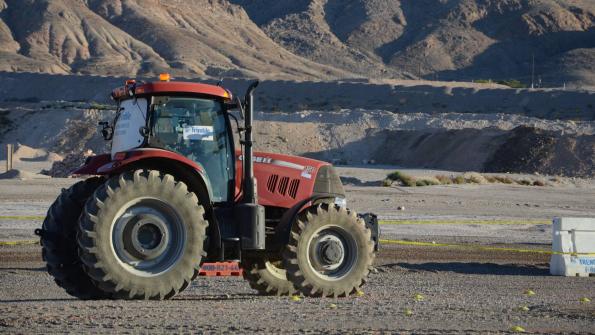November 23, 2016

The hot spot at the fall farm shows was a visit to the Case IH and New Holland exhibits to see machines that had been outfitted for autonomous work. The idea of the driverless tractor gets a lot of attention, as does the idea of driverless cars or robot semi-tractor trailer rigs. Trimble, a company involved in a range of autonomous projects is working on its own program, including work in agriculture.
Recently, the company showed off an autonomous demonstration during its Trimble Dimensions annual conference. At an off-site demonstration field, the company showed a working demonstration where a Case IH Puma 150 CVT had been converted to run on its own. Of course, Trimble has been involved in auto-steering systems for several years and as far back as 2004 it introduced software that could be used in this application: NextSwath. And in 2015 the software got an update for end-of-row turns.
Already, with a driver sitting in the cab, most of the work can be done by the tractor. But why the need for autonomy? Omar-Pierre Soubra, director of marketing communications, Trimble, explains that autonomous machines fall into the DDD category.
"They are used where it is Dangerous, Dirty or Dull," he notes. "There are already different levels of autonomy on the market. Google cars are more autonomous, but there are other applications."
Trimble has been involved with the OTTO self-driving semi-tractor trailer program. Recently, that truck made a 150 mile trip to deliver Budweiser from the plant to another location. The video shows the driver engaging the system then moving to the back to read a paper. The system will keep a semi properly engaged, and in its lane, along an Interstate highway.
So the Trimble ag-focused demonstration showed the Puma machine moving through a series of exercises – which you can see on the video above. John Peake, engineering manager, Trimble, was clear that this is a demonstration project and one that is not ready for prime time. "We are not selling this system, this is to show what's possible," he explains. In the video he explains the systems involved in making the machine work for the demonstration, and you can see the machine in action.
In fact, the system – during the demonstration – did stall out. It's still a work in progress, but did show the potential for driverless technology. For farmers, this may not mean giving up the "fun" of driving a tractor, but could build on your ability to get more work done in a day. Self-driving tractors with end-row turn capability already handle a lot of the driving of the machine.
For demonstration purposes, Peake showed how the tractor slows when an obstacle appears, and can come to a complete stop if the obstacle stays in the way. However, he says the Lidar system in use was fine for the demonstration it isn't "fine" enough for all obstacles. Note that the Case IH driverless-demo tractor on the stand at the fall shows had a more extensive sensor system than the one in the Trimble demo unit. This tech is coming a long way pretty quickly.
[CHARTBEAT:3]
Interesting to the Trimble demonstration was the video monitor that allows someone in a remote location to "check in" on a tractor to see how it is operating, and even take it over. During the demonstration, Peake started the tractor from an off-the-shelf computer tablet loaded with the autonomy software.
Check out the video above to see the machine in action and learn more about what Trimble built for this demonstration. The future of autonomous machinery may be nearer than we think.
About the Author(s)
You May Also Like






